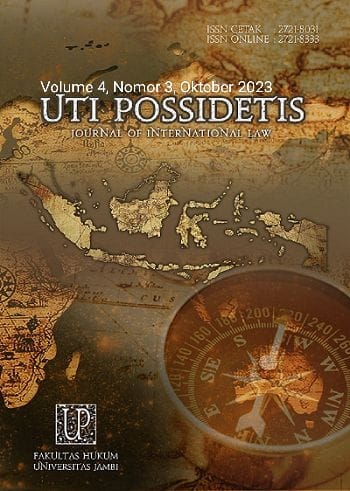Regionalism Approach on Management of Refugee to Protect Refugee Rights: Lesson learned from Africa and Asia Regions
DOI:
https://doi.org/10.22437/up.v4i3.25785Keywords:
refugees, refugee rights, Asia region, Africa regionAbstract
This study aims to explore the experience of managing refugees in other regions, such as Africa and Asia as well as the protection of their rights. This study focused on regions with developing countries but was not limited to. This study, which was qualitative in nature, looked at a variety of texts, including both scientific and grey-literature sources, and other periodicals. The literature was chosen based on relevance and had its information critically evaluated. The gathered data was systematically and legally examined. The 1951 Geneva Convention and the 1967 Protocol, as well as other international law sources pertaining to refugees, serve as the main legal sources in this study. Analytical thinking will be used to gather and analyze the data. Learning from more developed countries is also one of the efforts that are worth the try to build comprehensive cooperation. However, the unique characteristics of each region need to be taken into account for building a suitable model for managing refugees. Close coordination and cooperation with international bodies concerning refugees are also needed since countries have limited resources.
Downloads
References
Afriansyah, Arie, and Angky Banggaditya. “Refugee Burden Sharing: An Evolving Refugee Protection Concept?†Arena Hukum 10, no. 3 (2017): 333–56.
Ayoub, Maysa Abbas. “Understanding Germany’s Response to the 2015 Refugee Crisis.†Review of Economics and Political Science ahead-of-p, no. ahead-of-print (2019). https://doi.org/10.1108/reps-03-2019-0024.
Chimni, B. “The Changing World Order, the Structural Role of Humanitarian NGOs, and the Protection of Displaced Persons and Migrants.†In ICVA CONFERENCE, 2003.
Crock, Mary. “In the Wake of the Tampa: Conflicting Visions of International Refugee Law in the Management of Refugee Flows.†Pac. Rim L. & Pol’y J. 12 (2003): 49.
Ebobrah, Solomon T. “Sub-Regional Frameworks for the Protection of Asylum Seekers and Refugees in Africa: Bringing Relief Closer to Trouble Zones.†In Regional Approaches to the Protection of Asylum Seekers, 67–85. Routledge, 2016.
Fawcett, Louise. “The History and Concept of Regionalism.†In European Society of International Law (ESIL) Conference Paper Series, edited by Nico Krisch, Anne van Aaken, and Mario Prost. Valencia, 2012.
Gerver, Mollie. “Must Refugees Return?†Critical Review of International Social and Political Philosophy 24, no. 4 (2021): 415–36.
Ghezelbash, Daniel, and Nikolas Feith Tan. “The End of the Right to Seek Asylum? COVID-19 and the Future of Refugee Protection.†International Journal of Refugee Law 32, no. 4 (2020): 668–79.
Gil-Bazo, MarÃa-Teresa. “Asylum as a General Principle of International Law.†International Journal of Refugee Law 27, no. 1 (2015): 3–28.
Goodwin-Gill, Guy S, and Jane McAdam. The Refugee in International Law. 4th ed. Oxford: Oxford University Press, 2021.
Jones, Will, and Alexander Teytelboym. “Matching Systems for Refugees.†Journal on Migration and Human Security 5, no. 3 (2017): 667–81. https://doi.org/10.1177/233150241700500306.
Kneebone, Susan. “Controlling Migration by Sea: The Australian Case.†In Extraterritorial Immigration Control, 341–68. Brill Nijhoff, 2010.
———. “The Bali Process and Global Refugee Policy in the Asia–Pacific Region.†Journal of Refugee Studies 27, no. 4 (2014): 596–618.
———. “The Pacific Plan: The Provision of ‘Effective Protection’?†International Journal of Refugee Law 18, no. 3–4 (2006): 696–721.
———. “The Refugee–Trafficking Nexus: Making Good (the) Connections.†Refugee Survey Quarterly 29, no. 1 (2010): 137–60.
Loescher, Gil. “Introduction: Refugee Issues in International Relations.†Refugees and International Relations, 1989, 1–33.
Long, Katy. The Point of No Return: Refugees, Rights, and Repatriation. OUP Oxford, 2013.
Macaraig, Christine Elizabeth, and Fariz Pradipta Mursyid. “The Plight of Refugees in ASEAN Member Countries.†Technium Soc. Sci. J. 15 (2021): 633.
Maiani, Francesco. “The Reform of the Dublin System and the Dystopia of ‘Sharing People.’†Maastricht Journal of European and Comparative Law 24, no. 5 (2017): 622–45. https://doi.org/10.1177/1023263X17742815.
Missbach, Antje. “Accommodating Asylum Seekers and Refugees in Indonesia: From Immigration Detention to Containment in ‘Alternatives to Detention.’†Refuge 33, no. 2 (2017): 32–44.
Moretti, Sebastien. “Between Refugee Protection and Migration Management: The Quest for Coordination between UNHCR and IOM in the Asia-Pacific Region.†Third World Quarterly 42, no. 1 (2021): 34–51.
Moussalli, Michell. “Who Is a Refugee?†Refugee Magazine UNHCR, 1982.
Palattiyil, George, Dina Sidhva, Amelia Seraphia Derr, and Mark Macgowan. “Global Trends in Forced Migration: Policy, Practice and Research Imperatives for Social Work.†International Social Work 65, no. 6 (2022): 1111–29.
Thielemann, Eiko, Richard Williams, and Christina Boswell. “What System of Burden-Sharing between Member States for the Reception of Asylum Seekers?,†2010, 195. http://eprints.lse.ac.uk/30051/.
UNHCR. “Trends at a Glance: Global Trends Forced Displacement in 2019.†UNHCR The UN Refugee Agency, 2020, 1–84. https://www.unhcr.org/5ee200e37.pdf.
United Nations High Commissioner for Refugees. “Refugee Statistics.†Refugee Data Finder, 2023. https://www.unhcr.org/refugee-statistics/.
———. “United Nation Report about Refugee.†New York, 1998.
Downloads
Published
How to Cite
Issue
Section
License
Copyright (c) 2023 Ayub Torry Satriyo Kusumo

This work is licensed under a Creative Commons Attribution 4.0 International License.







